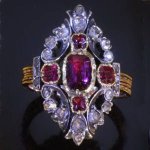We offer layaway, spread payments on the piece of your dreams. Ask us for details. Free insured shipping on all orders !!!
Combinations of Metals

The combination of different metals in jewellery has deep historical roots. Two to three centuries ago, it was customary to set diamonds in silver, as craftsmen believed that only a silver setting could truly enhance a precious stone’s brilliance. To protect the jewellery and the wearer, the backs of these pieces were typically crafted in gold. This silver-on-gold technique—where a thin layer of gold covered the back of a silver jewel—was designed to prevent silver from leaving black marks on clothing or skin.
Today, antique silver jewellery often appears dark due to oxidation, but this was never the original intention. In its time, silver settings were highly polished to a mirror-like shine, ensuring that the transition between the silver mount and the diamond was almost invisible to the naked eye.
As jewellers became accustomed to working with layered metals, this practice continued into the late 19th and early 20th centuries. However, instead of silver, they began using platinum—a metal as valuable as gold but without the tendency to tarnish.
The widespread use of platinum in jewellery only became feasible after advancements in high-temperature torches. Platinum has a melting point of approximately 1,768°C (3,214°F), making it difficult to work with using traditional goldsmithing techniques. While the oxyhydrogen torch was developed in the late 18th century and could reach temperatures high enough to melt platinum, its application was initially limited to laboratories. It was only in the second half of the 19th century that these techniques became available in jewellery workshops. French jeweller Cartier was among the pioneers who introduced platinum in fine jewellery, taking advantage of its strength and bright white appearance.
Interestingly, during the 16th century, Spanish conquistadors in South America encountered platinum but had no way of recognising its value. With their limited technology, they were unable to smelt it, leading them to view it as a nuisance. They referred to it as "platina" (*little silver*) and often discarded it while mining for gold. Some accounts suggest that they even threw platinum overboard to prevent counterfeiters from using it to adulterate gold.
While the use of yellow or red gold as a backing for white (silver) jewels had initially served a practical purpose—to prevent silver from tarnishing and staining—the introduction of platinum removed this necessity. From that point onward, the combination of metals became more about aesthetic appeal rather than functionality.
The combination of metals remained popular, particularly in the 1940s, when contrasting gold tones became a defining feature of Retro jewellery. This era saw the creative use of rose gold, yellow gold, and white gold, often combined in bold, sculptural designs.
An Endearing Urban Legend Circulates
Contrary to its current status, platinum was not always considered a precious metal. In early 19th-century Russia, counterfeiters discovered that platinum’s high density made it ideal for forging gold roubles. By coating a platinum core with a thin layer of gold, they created coins that were almost indistinguishable from solid gold roubles.
It wasn’t until around 1870 that platinum gained recognition as a valuable metal, leading to a surge in its price. According to legend, old roubles were later cut in half in the hope of finding platinum inside—whether true or not, it remains an intriguing tale from the era of monetary deception.









